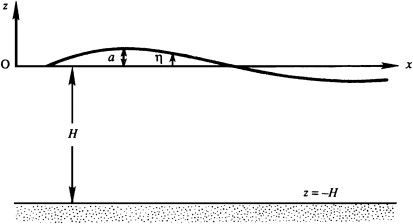
Choose the x-axis in the direction of wave propagation with the z-axis vertical so that the motion is two-dimensional in the x-z plane.
Let the surface’s vertical deflection or waveform \( \eta(x,t) \) denote the vertical liquid-surface displacement from its undisturbed location \( z = 0 \)
Because the liquid’s motion is irrotational, a velocity potential \( \phi(x, z, t) \) can be defined
\(\boxed{
u = \partial \phi / \partial x,
w = \partial \phi / \partial z}
\)
so the incompressible continuity equation \( \partial u / \partial x + \partial w / \partial z = 0 \) implies
\(\boxed{
\partial^2 \phi / \partial x^2 + \partial^2 \phi / \partial z^2 = 0}
\)
There are three boundary conditions.
◀ ▶